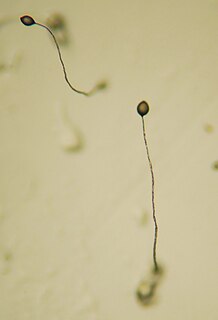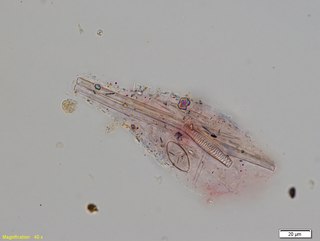
Amoebozoa is a major taxonomic group containing about 2,400 described species of amoeboid protists, often possessing blunt, fingerlike, lobose pseudopods and tubular mitochondrial cristae. In most classification schemes, Amoebozoa is ranked as a phylum within either the kingdom Protista or the kingdom Protozoa. In the classification favored by the International Society of Protistologists, it is retained as an unranked "supergroup" within Eukaryota. Molecular genetic analysis supports Amoebozoa as a monophyletic clade. Most phylogenetic trees identify it as the sister group to Opisthokonta, another major clade which contains both fungi and animals as well as some 300 species of unicellular protists. Amoebozoa and Opisthokonta are sometimes grouped together in a high-level taxon, variously named Unikonta, Amorphea or Opimoda.

The opisthokonts are a broad group of eukaryotes, including both the animal and fungus kingdoms. The opisthokonts, previously called the "Fungi/Metazoa group", are generally recognized as a clade. Opisthokonts together with Apusomonadida and Breviata comprise the larger clade Obazoa.

Lobosa is a taxonomic group of amoebae in the phylum Amoebozoa. Most lobosans possess broad, bluntly rounded pseudopods, although one genus in the group, the recently discovered Sapocribrum, has slender and threadlike (filose) pseudopodia. In current classification schemes, Lobosa is a subphylum, composed mainly of amoebae that have lobose pseudopods but lack cilia or flagella.

Sequence homology is the biological homology between DNA, RNA, or protein sequences, defined in terms of shared ancestry in the evolutionary history of life. Two segments of DNA can have shared ancestry because of three phenomena: either a speciation event (orthologs), or a duplication event (paralogs), or else a horizontal gene transfer event (xenologs).

Unikonts or Amorphea are members of a taxonomic supergroup that includes the basal Amoebozoa and Obazoa. That latter contains the Opisthokonta, which includes the Fungi, Animals and the Choanomonada, or Choanoflagellates. The taxonomic affinities of the members of this clade were originally described and proposed by Thomas Cavalier-Smith in 2002.

Chaos is a genus of amoebae, in the family Amoebidae. The largest and best-known species, the so-called "giant amoeba", can reach lengths of 5 mm, although most specimens fall between 1 and 3 mm.

The Amoebidae are a family of Amoebozoa, including naked amoebae that produce multiple pseudopodia of indeterminate length. These are roughly cylindrical with granular endoplasm and no subpseudopodia, as found in other members of the class Tubulinea. During locomotion one pseudopod typically becomes dominant and the others are retracted as the body flows into it. In some cases the cell moves by "walking", with relatively permanent pseudopodia serving as limbs.

Amoeba proteus , of which Chaos diffluens is one of many synonyms, is a large amoeba related to another genus of giant amoebae, Chaos. It can be bought at science supply stores.
dictyBase is an online bioinformatics database for the model organism Dictyostelium discoideum.

The Tubulinea are a major grouping of Amoebozoa, including most of the more familiar amoebae genera like Amoeba, Arcella, Difflugia and Hartmannella

Dictyostelium discoideum is a species of soil-dwelling amoeba belonging to the phylum Amoebozoa, infraphylum Mycetozoa. Commonly referred to as slime mold, D. discoideum is a eukaryote that transitions from a collection of unicellular amoebae into a multicellular slug and then into a fruiting body within its lifetime. Its unique asexual lifecycle consists of four stages: vegetative, aggregation, migration, and culmination. The lifecycle of D. discoideum is relatively short, which allows for timely viewing of all stages. The cells involved in the lifecycle undergo movement, chemical signaling, and development, which are applicable to human cancer research. The simplicity of its lifecycle makes D. discoideum a valuable model organism to study genetic, cellular, and biochemical processes in other organisms.

Himatismenida is an Amoebozoa order, in the class Discosea, along with Glycostylida and Dermamoebida. It contains species such asCochliopodium gallicum.

Thecamoebidae is an Amoebozoa family.

Testate amoebae are a polyphyletic group of unicellular amoeboid protists, which differ from naked amoebae in the presence of a test that partially encloses the cell, with an aperture from which the pseudopodia emerge, that provides the amoeba with shelter from predators and environmental conditions.
Sappinia pedata is a species of Amoebozoa. Sappinia is a free-living amoeba, found in the environment. This organism can cause granulomatous amoebic encephalitis (GAE), However, only one case of GAE due to S. pedata infection has ever been reported, and the patient survived without any long-term consequences.
Copromyxa is a genus of Amoebozoa in the eukaryotic supergroup Amoebozoa. It currently includes 2 species, the sorocarpic amoeba Copromyxa protea and the non-sorocarpic amoeba Copromyxa (=Hartmannella) cantabrigiensis. There is also a species Copromyxa arborescens, which is a synonym of C. protea.

The Eukaryotic Pathgen Database, or EuPathDB, is a database of bioinformatic and experimental data related to a variety of eukaryotic pathogens. It was established in 2006 under a National Institutes of Health program to create Bioinformatics Resource Centers to facilitate research on pathogens that may pose biodefense threats. EuPathDB stores data related to its organisms of interest and provides tools for searching through and analyzing the data. It currently consists of 14 component databases, each dedicated to a certain research topic. EuPathDB includes:

An amoeba or ameba, often called an amoeboid, is a type of cell or unicellular organism which has the ability to alter its shape, primarily by extending and retracting pseudopods. Amoebae do not form a single taxonomic group; instead, they are found in every major lineage of eukaryotic organisms. Amoeboid cells occur not only among the protozoa, but also in fungi, algae, and animals.

Mark Boguski is an American pathologist specializing in computational analysis and structural biology, He was elected in 2001 to the U.S. National Academy of Medicine, and is a Fellow of the American College of Medical Informatics.












